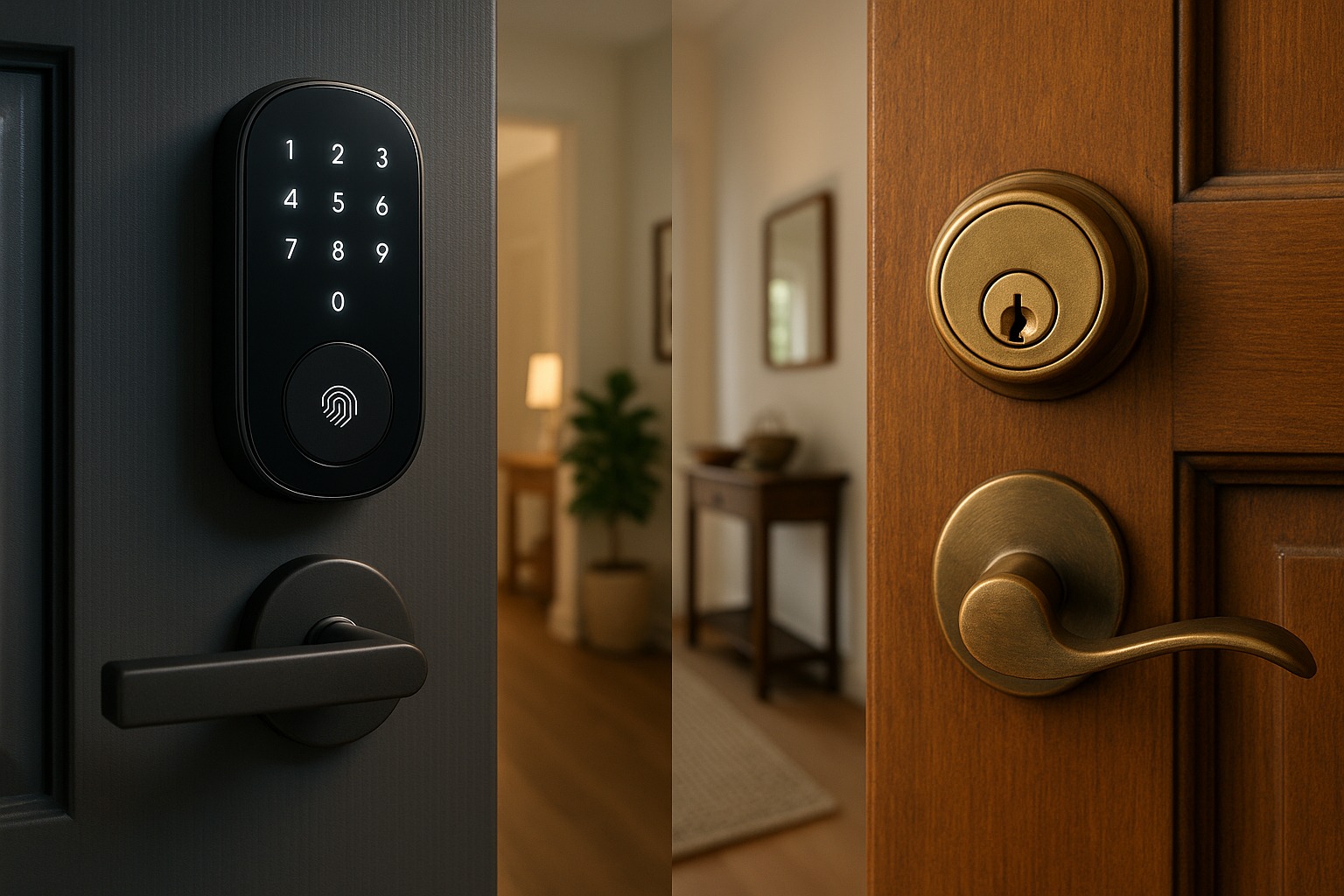In today’s world of rapidly advancing technology, even something as basic as locking your front door has gone digital. Homeowners are now faced with a choice: stick with traditional locks that have secured homes for centuries, or upgrade to smart locks that offer high-tech features like keyless entry, remote control, and smartphone integration.
As more people embrace smart home security systems, the debate between smart locks vs traditional locks continues to heat up. Each option has its own strengths—and weaknesses—when it comes to safety, convenience, and reliability. In this guide, we’ll break down the key differences, explore the pros and cons of smart locks and mechanical locks, and help you decide which type is the better fit for your lifestyle.
Whether you’re a tech-savvy homeowner or someone who prefers the simplicity of a key-and-lock system, understanding both options will help you make a smarter decision for your home’s security.
Smart locks vs traditional locks is a common comparison for homeowners upgrading their security. Smart locks offer keyless convenience, remote control, and app-based monitoring, while traditional locks rely on physical keys and time-tested mechanical strength. If you value automation, remote access, and smart home integration, smart locks are a modern upgrade. However, for simplicity, low cost, and no tech reliance, traditional locks still hold their ground. The best choice depends on your lifestyle, budget, and security preferences.
What Are Smart Locks?
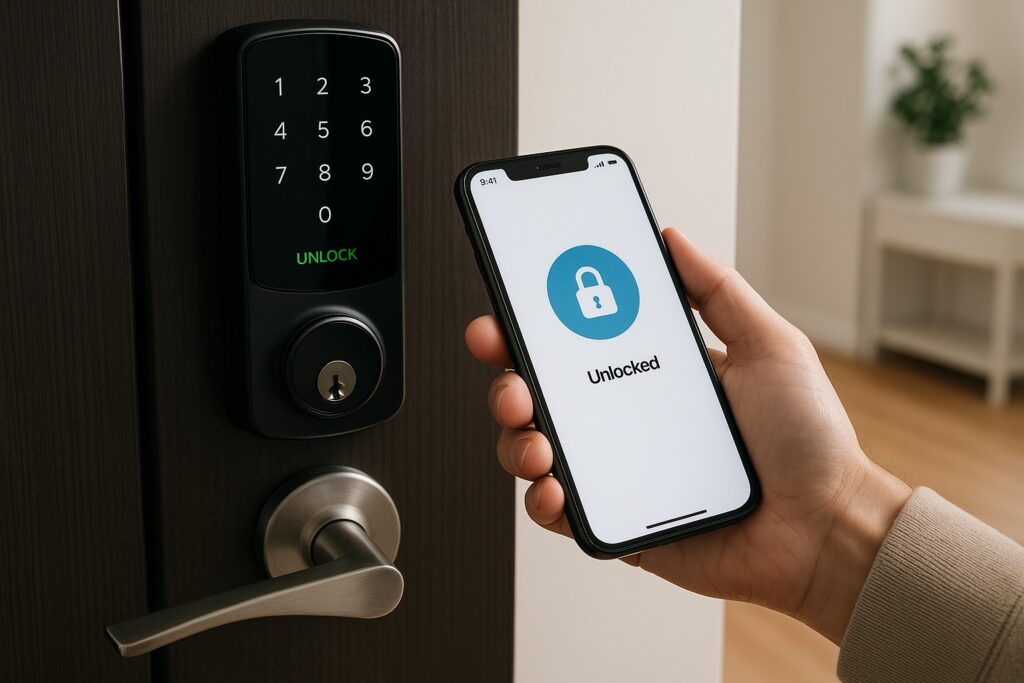
Smart locks are electronic locking systems designed to replace or upgrade your existing door lock using digital technology. Unlike traditional locks that rely on physical keys, smart locks provide keyless entry options, allowing you to unlock your door using a smartphone app, PIN code, biometric fingerprint, or even voice control through smart assistants like Alexa or Google Assistant.
These locks use wireless protocols such as Wi-Fi, Bluetooth, Z-Wave, or Zigbee to connect with your home network or smart hub. This enables remote access, letting you control or monitor your door from anywhere in the world. Some smart locks also feature auto-locking, activity logs, and guest access codes—ideal for Airbnb hosts, busy families, or frequent travelers.
With increasing demand for smart home integration, smart locks are becoming a key component of modern home security systems. They’re often used alongside smart doorbells, security cameras, and alarm systems, offering a more seamless and secure living experience. While they do require power (usually batteries), most models send low-battery alerts and have mechanical key overrides as backup.
What Are Traditional Locks?
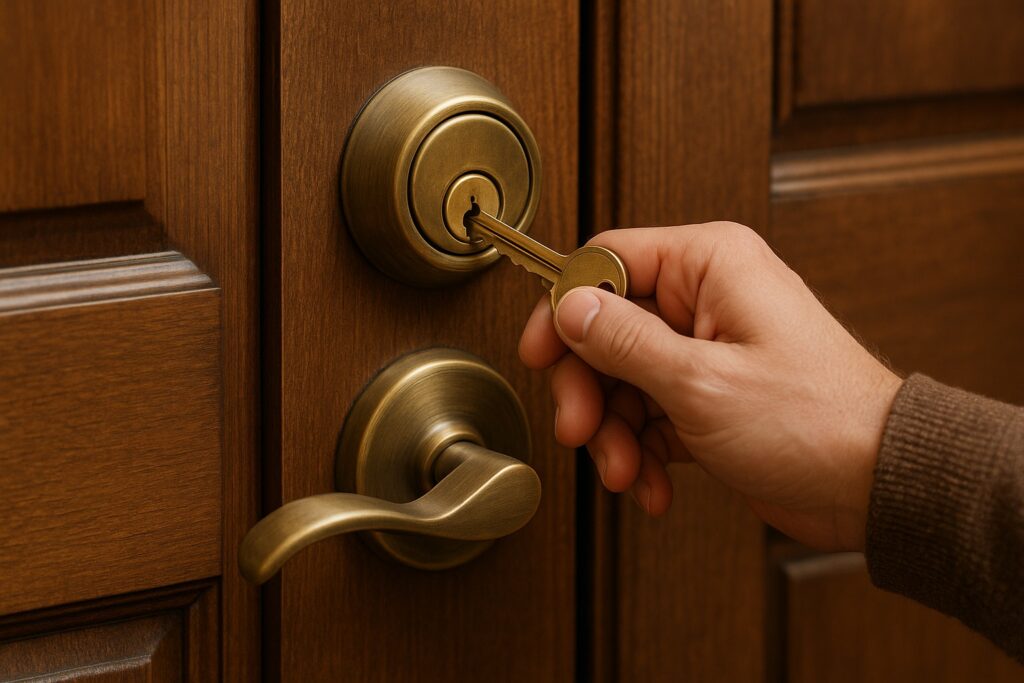
Traditional locks are mechanical locking systems that use physical keys to secure doors. These locks have been the go-to security method for centuries and remain widely trusted for their simplicity, affordability, and mechanical durability. Common types include deadbolt locks, knob locks, lever handle locks, and mortise locks, all of which operate using a system of pins, tumblers, or bolts that require manual key operation.
Unlike smart locks, traditional door locks don’t rely on batteries, apps, or internet connectivity. This makes them low maintenance and highly reliable in power outages or technical failures. You don’t have to worry about hacking risks or software malfunctions—just insert the key and turn.
However, traditional locking mechanisms also come with limitations. Lost or stolen keys can be a major vulnerability, and physical keys can be copied without your knowledge. There’s also no remote access or monitoring, which means you can’t check or control the lock while you’re away.
For homeowners who prefer a no-frills, proven security solution, traditional locks remain a dependable option—especially when reinforced with high-security deadbolts or paired with physical surveillance systems.
🔄 Key Differences Between Smart Locks and Traditional Locks
When comparing smart locks vs traditional locks, the most important differences come down to technology, convenience, control, and security features. Each type has its own unique strengths that suit different lifestyles and levels of comfort with tech.
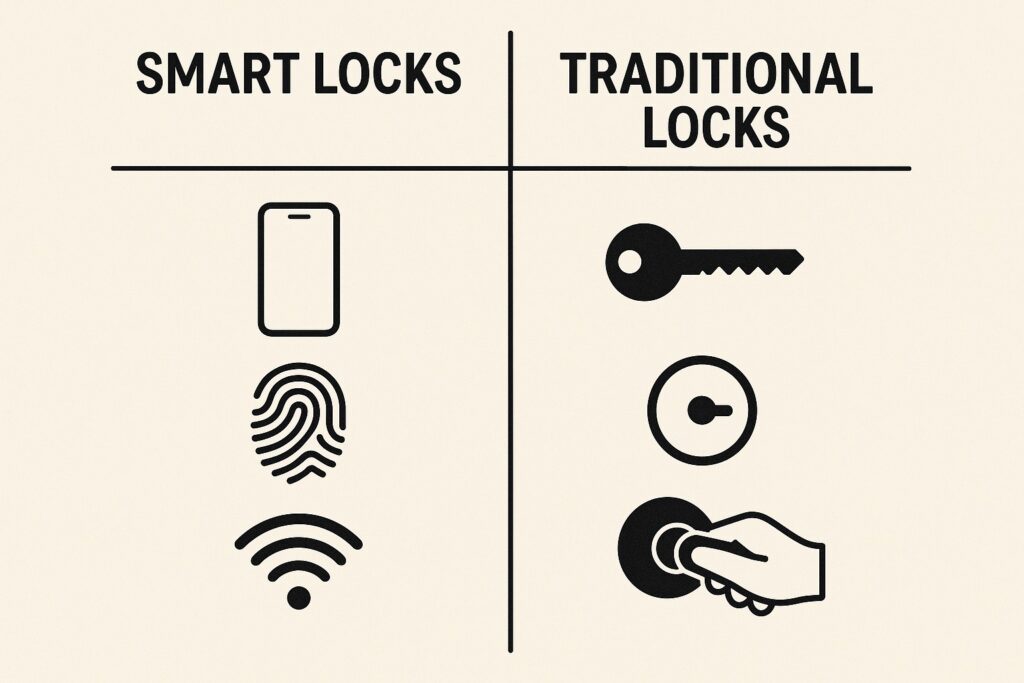
🔹 1. Technology & Functionality
Traditional locks use purely mechanical components—no batteries, no apps, and no internet. In contrast, smart locks rely on digital technology and often need Wi-Fi, Bluetooth, or smart hubs to function. They can integrate with your smart home ecosystem, offering features like remote control, access logs, auto-lock timers, and virtual keys.
🔹 2. Access Control
With traditional locks, access is limited to whoever holds a physical key. Smart locks, on the other hand, provide flexible access through mobile apps, PIN codes, fingerprint scanners, or even voice assistants. You can send virtual keys to family, guests, or service providers, and revoke them anytime.
🔹 3. Security Mechanisms
Both lock types aim to protect your home, but their vulnerabilities differ. Traditional locks may be susceptible to lock-picking or bump keys, while smart locks introduce cybersecurity concerns like hacking or signal jamming. High-end models in both categories come with added reinforcements (e.g., anti-drill plates, encryption protocols).
🔹 4. Power Source
Traditional locks don’t require power—they’re always ready to use. Smart locks need battery power, and may stop functioning if the battery dies (though many include backup key access or emergency power options).
🔹 5. Convenience & Automation
Smart locks are built for ease of use and automation. You can unlock your door while driving home, get notified if it’s left open, or schedule it to auto-lock. Traditional locks offer no automation—you always need your key.
✅ Pros and Cons of Smart Locks
Smart locks are transforming how we secure and access our homes, offering a blend of modern tech and convenience. But like all devices, they come with both benefits and trade-offs. Let’s explore the key advantages and disadvantages of smart locks so you can decide if they’re the right choice for your home.
🔹 Pros of Smart Locks
🔑 1. Keyless Entry & Remote Access
One of the biggest perks of smart locks is keyless convenience. You can lock or unlock your door using a smartphone app, PIN code, fingerprint scanner, or even voice command. Forget digging for keys—just tap your phone.
🌐 2. Remote Monitoring and Control
Smart locks let you control your door from anywhere. Whether you’re at work or on vacation, you can check if it’s locked, grant access to visitors, or even get real-time alerts when someone enters or exits your home.
👥 3. Guest and Family Access
You can generate temporary virtual keys for guests, babysitters, or cleaners. Some locks let you create unique PINs for each person and track when they use them.
🔄 4. Integration with Smart Home Systems
Smart locks work seamlessly with Google Home, Amazon Alexa, Apple HomeKit, and other smart home platforms. You can create automation routines—like unlocking the door and turning on lights when you arrive.
🔻 Cons of Smart Locks
🔋 1. Battery Dependency
Most smart locks are battery-powered. If the battery dies and you don’t have a backup key or power source, you could get locked out. Some models send alerts when power is low, but it still requires consistent maintenance.
🌐 2. Connectivity Issues
Smart locks rely on Wi-Fi, Bluetooth, or Zigbee, and can occasionally suffer from disconnection, delays, or syncing issues—especially in weak signal areas.
🛡️ 3. Cybersecurity Risks
While rare, smart locks can be vulnerable to hacking or signal spoofing. That’s why it’s important to choose models with end-to-end encryption and two-factor authentication features.
💸 4. Higher Upfront Cost
Smart locks are generally more expensive than traditional locks, often ranging from $100 to $300+. Plus, some require professional installation or smart hubs.
✅ Pros and Cons of Traditional Locks
While smart locks are gaining popularity, traditional mechanical locks still remain a reliable and time-tested option for millions of homeowners. Let’s look at what makes them dependable—and where they fall short compared to smart alternatives.
🔹 Pros of Traditional Locks
🛠️ 1. Proven Mechanical Reliability
Traditional locks have stood the test of time. With no digital parts or software, they offer consistent, no-fail performance as long as you have the key. No batteries, no app crashes—just simple mechanics.
💰 2. Cost-Effective
One of the biggest advantages of traditional locks is their affordability. A basic high-quality deadbolt can cost less than $50, making it ideal for homeowners on a budget.
🔧 3. Easy to Install and Maintain
These locks are easy to install, often without professional help, and require little to no maintenance. There’s no need to update firmware or worry about connectivity.
⚡ 4. Immune to Hacking or Power Failures
Since they don’t rely on digital systems, traditional locks can’t be hacked or affected by Wi-Fi outages, low battery, or signal jamming—something that makes them especially appealing for less tech-savvy users.
🔻 Cons of Traditional Locks
🗝️ 1. Risk of Lost or Stolen Keys
Losing a physical key means you’re locked out—and if someone finds it, they have access. This creates a major security risk, especially if spare keys are poorly hidden.
🚪 2. No Remote Access or Control
You can’t lock or unlock your door remotely, assign guest access, or receive entry alerts. You have to be physically present every time—making it less convenient for busy lifestyles or frequent travelers.
🔑 3. Keys Can Be Duplicated
Even without your knowledge, physical keys can be copied. If you’ve ever handed a key to a third party, there’s always a chance it’s been duplicated.
💡 4. No Smart Integration
If you’re building a smart home, traditional locks can’t sync with voice assistants, smart lights, or alarm systems. They work alone and don’t contribute to smart routines or automation.
🛡️ Security Comparison: Which Lock Type Is Safer?
When it comes to protecting your home, security is everything. So, which offers better protection: a traditional lock or a smart lock? The answer depends on the type of threat you’re most concerned about—physical break-ins or digital vulnerabilities.
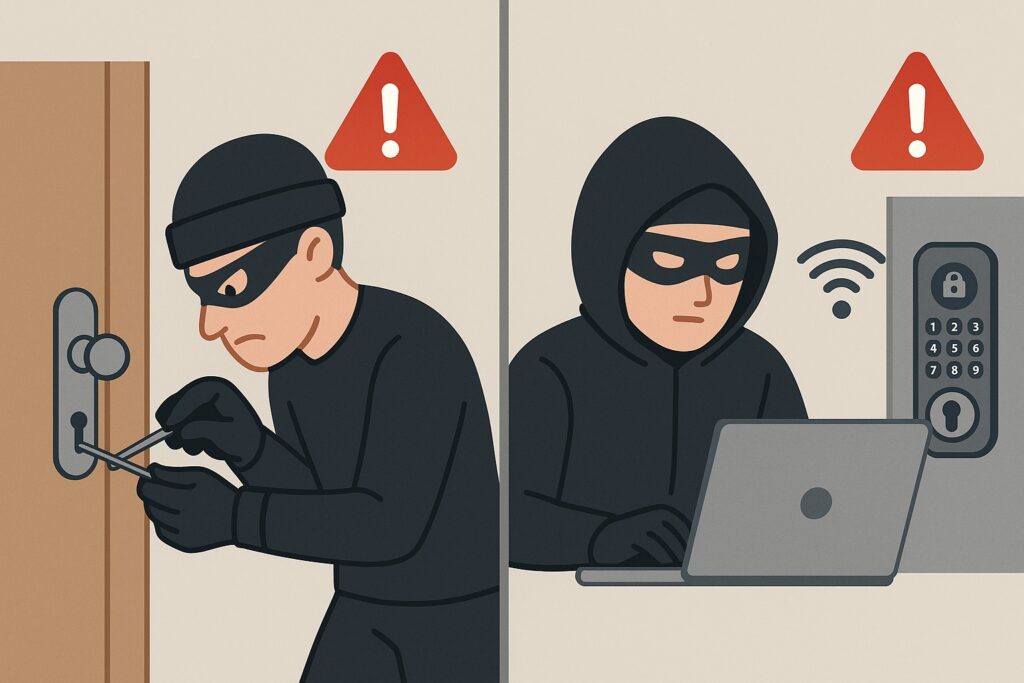
🔐 Traditional Locks: Strength in Simplicity
Traditional locks like deadbolts and mortise locks are known for their physical durability. High-quality models made from hardened steel can resist brute force attacks, drilling, and lock picking to a certain extent. However, cheaper locks can be vulnerable to bump keys, a tool used by intruders to silently break in.
Another concern is key duplication—if someone gets a copy of your key, your security is instantly compromised. Still, for people who don’t want to rely on technology, mechanical locks offer peace of mind by avoiding risks like hacking or Wi-Fi failure.
📲 Smart Locks: Digital Security with Flexibility
Smart locks offer more control and visibility—you can monitor who enters, get alerts, and even lock or unlock the door remotely. Some models feature two-factor authentication, end-to-end encryption, and tamper alerts, providing high-level digital security.
However, smart locks are not immune to cyber threats. Potential risks include Bluetooth spoofing, Wi-Fi jamming, and even software vulnerabilities—especially in cheaper or poorly updated models. If you’re going smart, opt for brands with a strong security track record and regularly update firmware.
🧠 So, Which One Is Safer?
- For low-tech, physical reliability, a high-quality traditional lock is tough to beat.
- For flexibility, real-time control, and integration, smart locks shine—if you’re comfortable managing digital risks.
The best security might come from combining both: use a smart lock with a traditional deadbolt for layered protection.
🧭 Which Lock Should You Choose?
Choosing between a smart lock and a traditional lock isn’t a one-size-fits-all decision. It depends on your home type, budget, daily routine, and your comfort level with technology. Here’s how to decide what’s best for your situation:
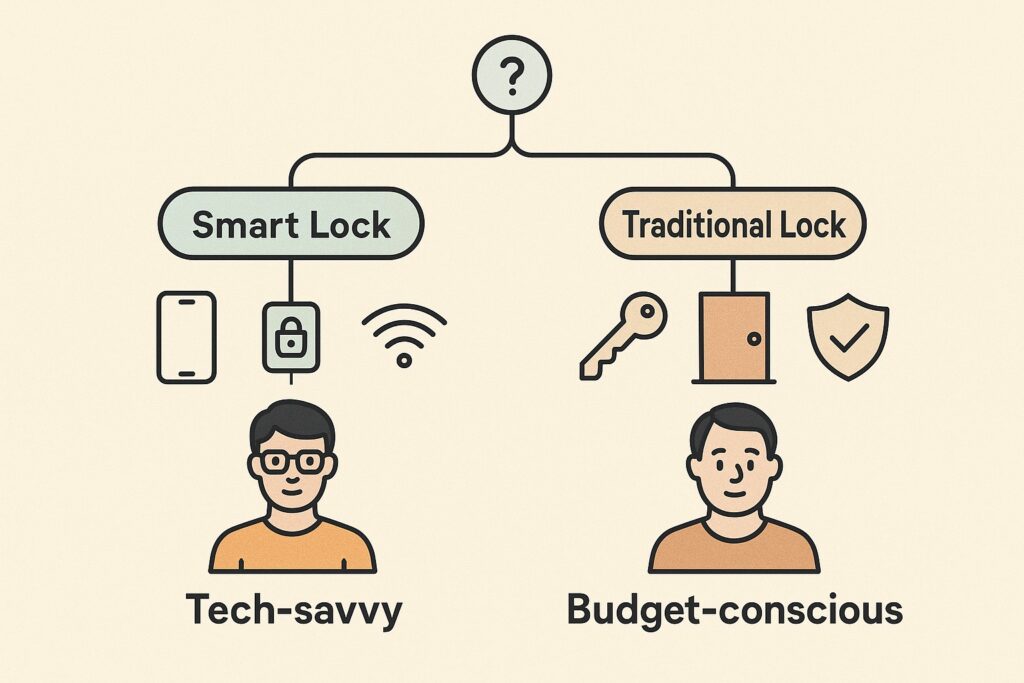
🏡 For Homeowners Building a Smart Home: Go Smart
If your house is already equipped with smart home devices like cameras, thermostats, and smart lighting, a smart lock is the natural next step. It allows full automation and remote access, giving you control of your front door from anywhere.
Great for:
- Busy professionals
- Airbnb or rental property owners
- Tech-savvy families
- Smart home enthusiasts
💵 For Budget-Conscious or Low-Tech Users: Stick With Traditional
If you prefer simplicity, reliability, and low cost, traditional locks are a dependable option. There’s no app to install, no batteries to check, and no software to update—just a solid lock and key that works.
Great for:
- Elderly residents or non-tech users
- Budget homeowners or renters
- Rural or low-Wi-Fi areas
- Secondary doors or garages
🧠 Still Undecided? Consider a Hybrid Setup
Some homeowners choose both—a smart lock for the front door and traditional locks for side or back entrances. You get the convenience of smart tech where it matters most, while keeping traditional systems for backup.
🧩 Final Verdict: Smart Lock or Traditional Lock?
At the end of the day, the best lock is the one that fits your home security needs, lifestyle, and comfort level with technology. Both smart locks and traditional locks offer strong protection—but in very different ways.
If you’re looking for modern convenience, remote access, and smart integration, then a smart lock is a powerful upgrade. It’s ideal for those who want to monitor their home from anywhere, give digital access to guests, and automate their security setup.
On the other hand, if you want a low-maintenance, cost-effective, and reliable mechanical solution, traditional locks still do a fantastic job. They’ve been trusted for generations and are perfect for people who prefer no digital dependency.
For many homeowners, the best approach might be to combine both—a smart lock for the main door and traditional locks for secondary entrances, giving you the best of both worlds.
✅ Quick Comparison Table:
| Feature | Smart Locks | Traditional Locks |
|---|---|---|
| Access Method | App, PIN, Fingerprint, Voice | Physical Key |
| Remote Control | ✅ Yes | ❌ No |
| Battery/Power Needed | ✅ Yes (battery-powered) | ❌ No |
| Installation Difficulty | Moderate (may require pairing/setup) | Easy (DIY-friendly) |
| Price Range | 💰 $100–$300+ | 💰 $30–$100 |
| Smart Home Integration | ✅ Fully Compatible | ❌ Not Compatible |
| Hacking Risk | ⚠️ Possible (use strong security) | ❌ No hacking risk |
| Key Loss Risk | ❌ No physical key needed | ⚠️ Yes (can be lost or copied) |
FAQs
Smart locks offer advanced features like encryption, tamper alerts, and remote monitoring, which give you more control over your home security. However, they can be vulnerable to hacking or connectivity issues. Traditional locks rely on mechanical strength and are not exposed to digital risks but can be picked or bumped if not high quality. The safest approach is choosing a premium model from either category, or using both for layered protection.
Most smart locks will send low battery alerts well in advance. If the battery dies, many models have a mechanical key override or allow you to temporarily power them via a 9V battery. It’s a good idea to check the battery every few months or set up alerts via the app.
Yes, many smart locks can function locally using Bluetooth, meaning you can still lock or unlock the door via your phone when you’re nearby. However, features like remote access or real-time alerts typically require Wi-Fi or a smart home hub (e.g., Z-Wave or Zigbee).
Installation is generally straightforward, especially if the smart lock is designed to replace your existing deadbolt. Many models come with step-by-step instructions or app-guided setups. If you’re not comfortable with tools or wiring, professional installation is an option.
Cheaper traditional locks can be vulnerable to lock picking or bump keys. To avoid this, choose high-security deadbolts with features like anti-pick pins, drill-resistant housings, and reinforced strike plates.
Yes, and many homeowners do. You can install a smart lock for the main door and use traditional locks for side or back doors. Some even combine both on the same door—using a smart lock on top and a keyed deadbolt below for double protection.
You will also like:
Best Smart Doorbells in 2025
→ Perfect complement to your smart lock setup with video access and alerts.Best Smart Home Security Systems
→ A complete buyer’s guide for setting up a fully connected and secure home.What Is a Smart Home? Beginner’s Guide
→ Ideal for readers just starting out in the smart home journey.Top Smart Home Devices for Front Door Security
→ Smart cameras, sensors, and more to pair with any lock system.How to Secure Your Front Door the Smart Way
→ Actionable tips on combining hardware and technology for maximum protection.

